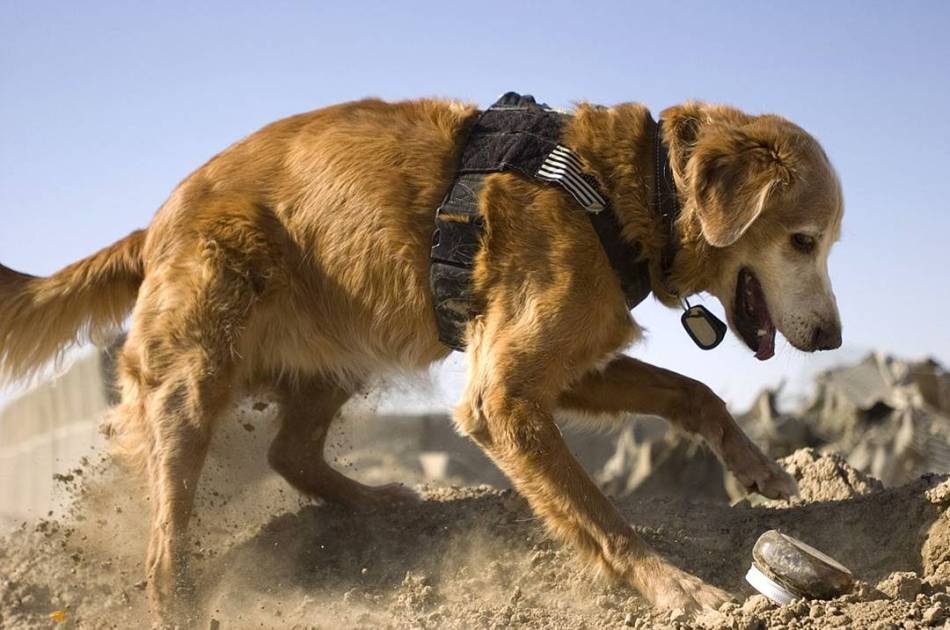Nov 20 2018
On a daily basis, thousands of trained K9 dogs sniff out explosives, narcotics, and missing people across the US. These dogs are vital for security; however, they are also very expensive and can get tired.
 Golden retriever Rudy, wearing military dog tags and a U.S. flag, is being trained by the U.S. Army to use his amazing nose to find human remains. (Credit: Army photo)
Golden retriever Rudy, wearing military dog tags and a U.S. flag, is being trained by the U.S. Army to use his amazing nose to find human remains. (Credit: Army photo)
Scientists at Duke University have taken the primary steps toward developing an artificial “robot nose” device. This device is made from living mouse cells and officers can use it instead of dogs.
The scientists have created a prototype based on odor receptors grown from the genes of mice that respond to target odors, including the smells of explosives and cocaine. Their work was featured earlier this month in Nature Communications.
The fact is there are a couple of huge differences between testing things in a lab dish and testing them in a real nose.
“This idea of an artificial nose has been present for a long time,” said senior study author Hiroaki Matsunami, a professor of molecular genetics and microbiology in the Duke School of Medicine. “The receptors were identified in the 1990s, but there are significant technical hurdles to produce all these receptors and monitor the activity so that we can use that in an artificial device.”
“E-noses” that exist currently use many chemical compounds to detect smells rather than receptor stem cells, Matsunami said. He added those devices are “not as good as a trained dog.”
The idea is that by using the actual, living receptors, maybe we can develop a device similar to animals. Nobody has achieved that yet, but this study is moving toward that goal.
Hiroaki Matsunami, Professor of Molecular Genetics and Microbiology, Duke School of Medicine
Human, mouse, and dog genomes contain about 20,000 genes, which possess instructions to produce proteins that smell, feel, taste, move and do everything that human bodies do. Approximately 5% of mouse genes have been identified as instructions to create odor receptors, Matsunami said. In contrast, humans just use roughly 2% of their genes to form odor receptors.
“These animals invest a lot of resources for this purpose,” Matsunami said. “Mice and rats are very good smellers; we just don’t use mice for detecting explosives in real life. There are some practical problems to do that.”
The initial step of the study was to identify the perfect odor receptors to respond to target odors like marijuana or cocaine.
The team developed a liquid medium primed with molecules that could light up from reactions. Then they copied about 80% of the odor receptors from mice, and mixed those receptors with seven target odor chemicals in the medium.
They measured the resulting luminescence and selected the best-performing odor receptors for the second part of the research, which monitored receptor activation in real time.
Earlier research had done this by exposing particular receptors to odor chemicals in a liquid. But there are a number of differences between the petri dish and the nose. One main difference is that a person seldom submerges his/her nose into liquid baths of odor chemicals. Instead, one’s nose detects stenches borne on the air or smells from wafting perfumes. Also, human noses are full of mucus.
Thus, for the second half of the research, which was supported by the National Institute of Health grants DC014423 and DC016224 and the Defense Advanced Research Project Agency RealNose Project, they tried to mimic how man uses the nose by exposing odorants to vapors and some enzymes.
The scientists tested the receptors they had spotted against two odor vapors for this research.
“We only tested two of them in the paper, but it’s showing the proof of principle of how it can be used,” Matsunami said.
The scientists hope they can tweak the device to test all receptors against numerous different smells.
“We have a panel of receptors so we can monitor how different receptors respond differently to various smells, including ones that are similar to each other in chemical structure or ones that might be related to real-world use, like something associated to explosives or drugs,” Matsunami said.
The scientists also tested different enzymes that are present in mucus to see how they assisted or obstructed reactions. This approach is more true-to-life than vapor molecules directly interacting with odor receptors.
“You’d think when we smell a chemical, the chemical would bind to the chemical receptor in the nose, but actually it’s not so simple,” Matsunami said. “When the chemical dissolves in the nasal mucus before binding to the receptor, it might be converted to another chemical by enzymes in the nasal mucus.”
Mucus is an unfamiliar frontier in understanding how humans smell. Reconstructing the main components of nasal mucus may be the subsequent step toward construction of an artificial nose, according to the paper.
It’s not like our paper will be immediately applied to a portable device used in the airport soon, but this is an important step forward to show that it is possible. We can more clearly see what kind of hurdles to pass in order for the community to create such a device.
Hiroaki Matsunami, Professor of Molecular Genetics and Microbiology, Duke School of Medicine
Three of the authors have filed a patent application for the research.